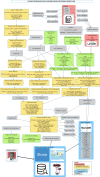GlobalFungi, a global database of fungal occurrences from high-throughput-sequencing metabarcoding studies
- PMID: 32661237
- PMCID: PMC7359306
- DOI: 10.1038/s41597-020-0567-7
GlobalFungi, a global database of fungal occurrences from high-throughput-sequencing metabarcoding studies
Erratum in
-
Author Correction: GlobalFungi, a global database of fungal occurrences from high-throughput-sequencing metabarcoding studies.Sci Data. 2020 Sep 15;7(1):308. doi: 10.1038/s41597-020-00647-3. Sci Data. 2020. PMID: 32934218 Free PMC article.
Abstract
Fungi are key players in vital ecosystem services, spanning carbon cycling, decomposition, symbiotic associations with cultivated and wild plants and pathogenicity. The high importance of fungi in ecosystem processes contrasts with the incompleteness of our understanding of the patterns of fungal biogeography and the environmental factors that drive those patterns. To reduce this gap of knowledge, we collected and validated data published on the composition of soil fungal communities in terrestrial environments including soil and plant-associated habitats and made them publicly accessible through a user interface at https://globalfungi.com . The GlobalFungi database contains over 600 million observations of fungal sequences across > 17 000 samples with geographical locations and additional metadata contained in 178 original studies with millions of unique nucleotide sequences (sequence variants) of the fungal internal transcribed spacers (ITS) 1 and 2 representing fungal species and genera. The study represents the most comprehensive atlas of global fungal distribution, and it is framed in such a way that third-party data addition is possible.
Conflict of interest statement
The authors declare no competing interests.
Figures



Similar articles
-
GlobalAMFungi: a global database of arbuscular mycorrhizal fungal occurrences from high-throughput sequencing metabarcoding studies.New Phytol. 2023 Dec;240(5):2151-2163. doi: 10.1111/nph.19283. Epub 2023 Oct 2. New Phytol. 2023. PMID: 37781910
-
Abrupt changes in the composition and function of fungal communities along an environmental gradient in the high Arctic.Mol Ecol. 2017 Sep;26(18):4798-4810. doi: 10.1111/mec.14227. Epub 2017 Aug 12. Mol Ecol. 2017. PMID: 28664999
-
Global Diversity and Biogeography of the Zostera marina Mycobiome.Appl Environ Microbiol. 2021 May 26;87(12):e0279520. doi: 10.1128/AEM.02795-20. Epub 2021 May 26. Appl Environ Microbiol. 2021. PMID: 33837008 Free PMC article.
-
Mycobiome diversity: high-throughput sequencing and identification of fungi.Nat Rev Microbiol. 2019 Jan;17(2):95-109. doi: 10.1038/s41579-018-0116-y. Nat Rev Microbiol. 2019. PMID: 30442909 Review.
-
The biogeography and conservation of Earth's 'dark' ectomycorrhizal fungi.Curr Biol. 2025 Jun 9;35(11):R563-R574. doi: 10.1016/j.cub.2025.03.079. Curr Biol. 2025. PMID: 40494311 Review.
Cited by
-
Defending Earth's terrestrial microbiome.Nat Microbiol. 2022 Nov;7(11):1717-1725. doi: 10.1038/s41564-022-01228-3. Epub 2022 Oct 3. Nat Microbiol. 2022. PMID: 36192539 Review.
-
Complementary Roles of Wood-Inhabiting Fungi and Bacteria Facilitate Deadwood Decomposition.mSystems. 2021 Jan 12;6(1):e01078-20. doi: 10.1128/mSystems.01078-20. mSystems. 2021. PMID: 33436515 Free PMC article.
-
Contrasting stability of fungal and bacterial communities during long-term decomposition of fungal necromass in Arctic tundra.Environ Microbiome. 2025 Jun 20;20(1):75. doi: 10.1186/s40793-025-00730-5. Environ Microbiome. 2025. PMID: 40542454 Free PMC article.
-
Unravelling the French National Fungal Database: Geography, Temporality, Taxonomy and Ecology of the Recorded Diversity.J Fungi (Basel). 2022 Aug 31;8(9):926. doi: 10.3390/jof8090926. J Fungi (Basel). 2022. PMID: 36135651 Free PMC article.
-
Forest microbiome and global change.Nat Rev Microbiol. 2023 Aug;21(8):487-501. doi: 10.1038/s41579-023-00876-4. Epub 2023 Mar 20. Nat Rev Microbiol. 2023. PMID: 36941408 Review.
References
-
- Crowther TW, et al. Quantifying global soil carbon losses in response to warming. Nature. 2016;540:104–108. - PubMed
-
- Peay KG, Kennedy PG, Talbot JM. Dimensions of biodiversity in the Earth mycobiome. Nature Rev. Microbiol. 2016;14:434–447. - PubMed
-
- Wall DH, Nielsen UN, Six J. Soil biodiversity and human health. Nature. 2015;528:69–76. - PubMed
-
- Tedersoo L, et al. Global diversity and geography of soil fungi. Science. 2014;346:1256688. - PubMed
-
- Bahram M, et al. Structure and function of the global topsoil microbiome. Nature. 2018;560:233–237. - PubMed
Publication types
MeSH terms
Grants and funding
LinkOut - more resources
Full Text Sources
Medical
Miscellaneous

